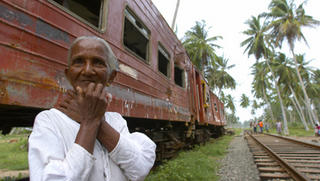Temporary Housing
Today our journey begins in earnest and we travel south for Galle. We visit the site of the Peraliya train disaster and find out exactly what 'temporary housing' means, nine months after the tsunami.

Driving south from Colombo evidence of the tsunami appears in patches, where the road skirts the ocean. It is difficult to see what is no longer there, the most obvious scar being the temporary housing. Wooden shacks are propped up where once existed a concrete home. I had imagined beamy constructions with solid columns and thick walls, but the reality was very disappointing. A concrete slab the size of a bedroom is walled in with thin planks of timber. Corrigated tin forms a roof and the weather comes in through a half foot gap below the eaves. The latter is useful when hot but problematic when it rains. The monsoon season has been running for five months.
As we continue south the prevalence of aid organisations becomes more apparent. New bus shelters advertise their benefactors, semi-rebuilt schools announce the generosity of World Vision, and clusters of temporary wooden houses are branded with 'Danish Peoples Aid'. And these are the lucky ones; many people are still living in tents or under tarpaulins, often pitched on a concrete slab which marks the remnants of their former home.
We reach Perilaya, the site of the infamous train derailment along the Colombo-Galle railway line. Several carraiges have been preserved at the site as a monument to the thousand or more people who died. The exact number was never determined because countless bodies were dragged out to sea with the retreating tide. It is a somber experience as we assume the role of tourists and take photographs of the wreckage. It is a sureal moment as children follow us with welcoming smiles - they ask for help, they ask for money, they ask us to build them a peoper house.
The walk back to our bus takes us through more of the danish built huts. I speak with one of the families and they show me inside the building. Manjula tells me about his sister and two brothers who are missing and shows me their photographs. The rest of the album contains indiscrimenent scenes from the days after December 26. Debris and rubbish conceal the ground in every direction, survivors carry victims away from the train carraiges, and dead bodies lie twisted and exposed. I find myself desensitising to the images and feel a little ashamed. I cannot help Manjula directy, I believe it better to work through the aid agencies like Habitat. His requests for help fall on deaf ears.
Temporay things have a way of becoming permanent, and nine months on there is little hope that people like Manjula will have a permanent home any time soon. A train rolls past along the new section of track, barely a metre away from the old wreckage. Life is getting back to normal... in parts.

Driving south from Colombo evidence of the tsunami appears in patches, where the road skirts the ocean. It is difficult to see what is no longer there, the most obvious scar being the temporary housing. Wooden shacks are propped up where once existed a concrete home. I had imagined beamy constructions with solid columns and thick walls, but the reality was very disappointing. A concrete slab the size of a bedroom is walled in with thin planks of timber. Corrigated tin forms a roof and the weather comes in through a half foot gap below the eaves. The latter is useful when hot but problematic when it rains. The monsoon season has been running for five months.
As we continue south the prevalence of aid organisations becomes more apparent. New bus shelters advertise their benefactors, semi-rebuilt schools announce the generosity of World Vision, and clusters of temporary wooden houses are branded with 'Danish Peoples Aid'. And these are the lucky ones; many people are still living in tents or under tarpaulins, often pitched on a concrete slab which marks the remnants of their former home.
We reach Perilaya, the site of the infamous train derailment along the Colombo-Galle railway line. Several carraiges have been preserved at the site as a monument to the thousand or more people who died. The exact number was never determined because countless bodies were dragged out to sea with the retreating tide. It is a somber experience as we assume the role of tourists and take photographs of the wreckage. It is a sureal moment as children follow us with welcoming smiles - they ask for help, they ask for money, they ask us to build them a peoper house.
The walk back to our bus takes us through more of the danish built huts. I speak with one of the families and they show me inside the building. Manjula tells me about his sister and two brothers who are missing and shows me their photographs. The rest of the album contains indiscrimenent scenes from the days after December 26. Debris and rubbish conceal the ground in every direction, survivors carry victims away from the train carraiges, and dead bodies lie twisted and exposed. I find myself desensitising to the images and feel a little ashamed. I cannot help Manjula directy, I believe it better to work through the aid agencies like Habitat. His requests for help fall on deaf ears.
Temporay things have a way of becoming permanent, and nine months on there is little hope that people like Manjula will have a permanent home any time soon. A train rolls past along the new section of track, barely a metre away from the old wreckage. Life is getting back to normal... in parts.

0 Comments:
Post a Comment
<< Home